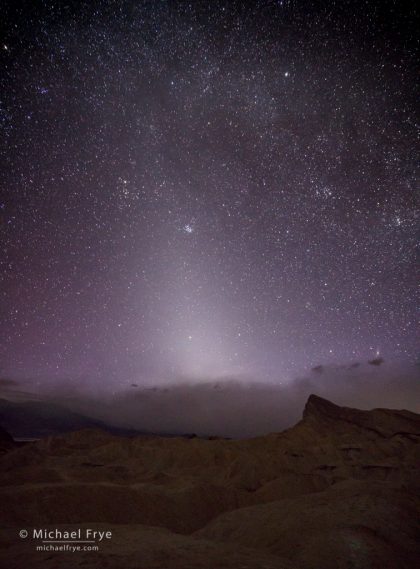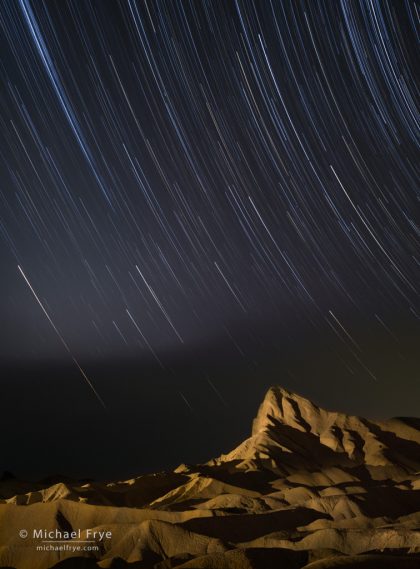On the last night of our Death Valley workshop we went down into Golden Canyon, preparing to capture a star-trail sequence above Manly Beacon. As the skies grew darker we noticed a low cloud in the main valley, behind the Beacon. It looked like fog or mist, but that didn’t make sense, since there hadn’t been any recent rain, and, well, we were in Death Valley, the driest place in North America. So we figured it had to be a dust storm.
It was gusty in Golden Canyon, but not windy enough to create a dust storm. Clearly, however, it was windier in the main valley. And the dust cloud seemed to be moving our way. We debated whether to leave or stick it out. It didn’t seem likely that the dust cloud would reach us, so we decided to wait a bit longer, and then a bit longer again.
As the skies got darker I noticed a triangle of light to the west. I asked Robert, my friend and assistant, if he knew what it was. He said he thought it was zodiacal light, which he had seen on a trip to Namibia. I’d heard of zodiacal light, but had never seen it before. I decided to quickly change compositions to capture this scene.
Cameras can often “see” better at night than our eyes, and that was true in this case. To our eyes this was a faint wedge of brighter light, but the camera showed this wedge – along with the dust cloud and Manly Beacon – much more clearly.
This article in Wikipedia says that zodiacal light is sunlight scattered by space dust in the zodiacal cloud. No, that doesn’t make much sense to me either, but the article explains it in more depth. It also says that it’s best observed in the western sky in the spring after the evening twilight has completely disappeared, or in the eastern sky in the autumn just before the morning twilight appears. This photograph was made looking west, in spring, in the evening, during the last minutes of astronomical twilight. And if you Google “zodiacal light” you’ll find many photos that look almost exactly like this one. So I have no doubt that zodiacal light, and it was pretty cool to see and photograph it. And now that I know where and when to look for it, I hope to see it again.
The wind gradually died down, and the dust cloud didn’t seem to be moving any closer, so were able to capture our star-trail sequences after all. The dust obscured the lower part of the sky, but created an interesting effect where the stars trails faded and became thinner as they descended into the dust:
Despite the wind we had a great time in Death Valley, and I’ll post more images from there soon.
— Michael Frye
Related Posts: A Photographer’s Playground; Sand Dune and the Milky Way
Michael Frye is a professional photographer specializing in landscapes and nature. He is the author or principal photographer of The Photographer’s Guide to Yosemite, Yosemite Meditations, Yosemite Meditations for Women, Yosemite Meditations for Adventurers, and Digital Landscape Photography: In the Footsteps of Ansel Adams and the Great Masters. He has also written three eBooks: Light & Land: Landscapes in the Digital Darkroom, Exposure for Outdoor Photography, and Landscapes in Lightroom: The Essential Step-by-Step Guide. Michael has written numerous magazine articles on the art and technique of photography, and his images have been published in over thirty countries around the world. Michael has lived either in or near Yosemite National Park since 1983, currently residing just outside the park in Mariposa, California.











Feels like bridging the gap between deep space photography with a telescope and our taking photos on a DSLR without a telescope. Surreal and beautiful!
Thanks Laura!
Hi Michael,
Great shot. Amazing what small dust particles can do as light scatterers.
For us in the Southern Hemisphere (and consistent with your text, in fact) the ZL gets to be best seen at dawn now. Come Spring in Aug/Sept, it’ll be best seen after sunset.
Thanks.
Thanks Antonio. Yes, of course it would be backwards down there. 🙂
Ah, wind… and Death Valley. Been there. 🙂
Just this last Monday, 3/27, I was shooting the stars towards the west in the Sierra foothills near Angel’s Camp just after 9:30pm. When I processed my photo, I saw this strange cluster of what look liked stars that I have never seen before. I was curious what they were. What perfect timing! My image shows the exact same cluster. Thanks so much Michael for the info! Fun to learn something new!
The star cluster is actually the Pleiades. The Zodiacal light in my photo is the triangle of brighter sky.
Hi Michael,
Really nice shoots! Wish I was there.
Cheers,
Alyn
Thanks Alyn!
Hi Michael
Your web page only shows a workshop in January (past) and one in April but from your blog there seems to have been other workshops not mentioned. How do I find out about any upcoming workshops that are not advertised on your web page?
Kathy, at this point the demand for my workshops far outstrips my ability to supply them. When a new workshop becomes available we usually announce it to our alumni, and if it doesn’t fill up right away (it usually does) then I send an email to my general list. I don’t know if I’ll post workshops on my website anymore, but if so it won’t be until after I send announcements to the aforementioned lists, so they’ll already be full.